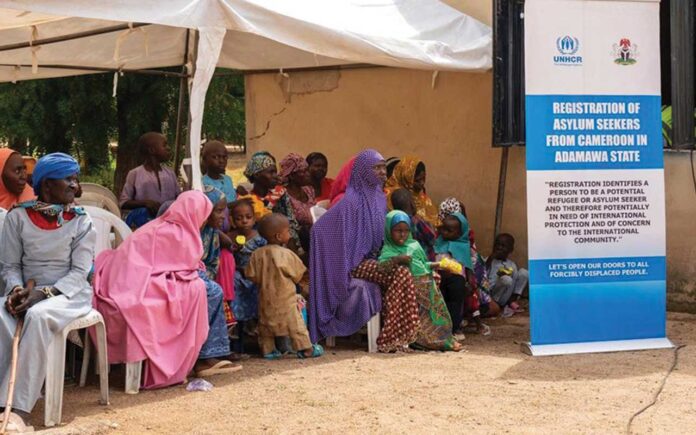A new report by the United Nations Humanitarian Office (UNHO) has revealed that conflict-affected communities in North East Nigeria are facing a worsening hunger crisis.
The UN said that despite ongoing efforts by humanitarian agencies, funding shortages are forcing aid providers to scale back life-saving support, leaving millions at risk.
In Borno, Adamawa, and Yobe states, known as the BAY states, hunger and malnutrition have reached critical levels. The 2025 Lean Season Multisectoral Plan shows that about one million children are at risk of severe acute malnutrition, double the number recorded in 2024. Between June and August 2025, over 600,000 children were projected to face life-threatening conditions without access to emergency nutrition services.
Fatima Mohammed, 24, from Dipchari village in Borno State, represents the growing number of families struggling to survive. After fleeing her home in 2019 due to attacks by non-state armed groups, she resettled in Maiduguri. However, years later, her family continues to face hardship, worsened by the shutdown of internally displaced persons (IDP) camps and floods that destroyed their shelter and food reserves.
“We lost everything. There were days we had nothing to eat,” Fatima said.
At the stabilisation centre in Mashamari, Jere Local Government Area, managed by the International Rescue Committee (IRC) with support from the Nigeria Humanitarian Fund (NHF), Fatima’s two daughters, aged two and one, are being treated for severe acute malnutrition.
According to Dr. Muhammad Goni, who oversees treatment at the facility, the children were diagnosed with severe anaemia and intractable vomiting. “We were able to stabilise them, and now their condition is improving,” Goni said. Fatima added that her children have regained appetite and strength after weeks of treatment.
Humanitarian agencies have warned that her experience reflects a much larger crisis across the region. The Cadre Harmonisé analysis released in March 2025 projected that about 4.6 million people in the BAY states would experience acute food insecurity during the lean season.
However, humanitarian assistance is shrinking fast. “The number of people in need is greater than the resources we have,” a field coordinator with INTERSOS in Dikwa, Jacob Sulisma. He explained that their food distribution programme, supported by the World Food Programme (WFP), currently reaches only about 20 per cent of those in need.
The situation has led some displaced persons to resort to dangerous survival strategies. “Some IDPs are engaging in commercial sex work, petty theft, and ‘survival sex’. Others are reducing their food intake and relying on less nutritious options,” a field coordinator with the Grassroot Initiative for Strengthening Community Resilience, Alhaji Ali Abani, said.
Environmental and economic challenges are compounding the crisis. The UN Food and Agriculture Organisation reported that floods in 2024 submerged over 1.6 million hectares of farmland, causing crop losses valued at nearly one billion dollars. Although food prices slightly dropped in August 2025, insecurity, limited farm access, and high costs of agricultural inputs continue to limit food availability for both displaced families and host communities.
In May 2025, the Federal Government of Nigeria and the United Nations launched a $159.3 million appeal to address severe food insecurity and malnutrition during the lean season. The six-month plan aimed to support two million vulnerable people with food, nutrition, and health services. Yet, by September 2025, only $77.25 million—49 per cent of the target—had been received.
According to WFP Nigeria’s latest country brief, the agency is facing an 89 per cent shortfall in resources needed to sustain emergency food assistance between September 2025 and February 2026. The shortage has already forced WFP and UNICEF to suspend operations in 150 malnutrition clinics, placing nearly 300,000 children at higher risk of severe wasting.
“This is no longer just a humanitarian crisis. It’s a growing threat to regional stability as families pushed beyond their limits are left with nowhere to turn,” WFP Country Director, David Stevenson, said.
Despite these challenges, the Nigeria Humanitarian Fund allocated $14.5 million to support 67 projects targeting 385,000 people in the BAY states during the lean season, thanks to contributions from donors such as the United Kingdom, Germany, Sweden, Canada, Switzerland, Ireland, Qatar Charity, Norway, and Luxembourg. The Central Emergency Response Fund also provided $6 million in July 2025 for early interventions on acute malnutrition and food insecurity. Together, these funds covered about 13 per cent of the total appeal.
Humanitarian organisations are now calling on the Nigerian government, donors, and international partners to increase support to prevent further deterioration. They warn that without urgent funding, millions of children like Fatima’s daughters could face a future of hunger, malnutrition, and uncertainty in one of Nigeria’s most fragile regions.

